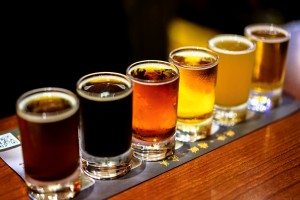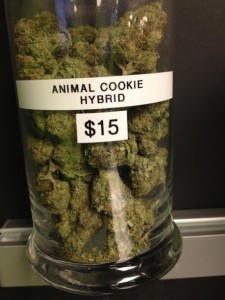by Rowshan Reordan, Green Leaf Lab
“Don’t judge a book by its cover.”
Or perhaps more appropriate for today, “Don’t judge all cannabis products by THC percentage.”
As the cannabis industry continues to develop, we will see more medical and recreational marijuana states require testing on cannabis and cannabis products. This means that potency, and THC percentages, are readily available for patients and consumers. As many know, the trend is to obtain cannabis products with the highest THC potency. But is this really the best product? Is this really the best choice for the consumer? Is a single THC percentage even accurate? In answering these questions we shall look specifically to the regulated industries of alcohol and analytical testing.
 The alcohol industry requires that all alcohol products be tested for potency, which is called alcohol content. While alcohol content is required to be posted on labels, how often does alcohol percentage affect your drink selection? When a friend offers you a beer they may ask you if you want an IPA, Kolsch, Ale or Stout. Or, when you are shopping for wine you may think about whether you want a Merlot, Chardonnay, Zinfandel, Rose, or Pinot Noir. Rarely is alcohol percentage the deciding factor. No one asks whether the beverage has 4%, 13% or even 95% alcohol content. If that was the case malt liquor and Ever Clear would be the alcohol of choice. Instead, what we see is that enthusiasts look for a wide variety of qualities other than just potency. The same should be said for cannabis.
The alcohol industry requires that all alcohol products be tested for potency, which is called alcohol content. While alcohol content is required to be posted on labels, how often does alcohol percentage affect your drink selection? When a friend offers you a beer they may ask you if you want an IPA, Kolsch, Ale or Stout. Or, when you are shopping for wine you may think about whether you want a Merlot, Chardonnay, Zinfandel, Rose, or Pinot Noir. Rarely is alcohol percentage the deciding factor. No one asks whether the beverage has 4%, 13% or even 95% alcohol content. If that was the case malt liquor and Ever Clear would be the alcohol of choice. Instead, what we see is that enthusiasts look for a wide variety of qualities other than just potency. The same should be said for cannabis.
Traditionally, the choosing of cannabis depended on its appearance, scents, and flavors. Selection was a holistic process. Potency still played an important role, but it was only qualifiable, not quantifiable. No one knew what THC percentage was. They just knew how they felt after consuming their favorite cannabis product. With the new industry of laboratory-tested cannabis, many cannabis consumers are no longer relying upon scents, flavors, and appearances. They are choosing their cannabis based on a very specific number, and sadly, an extremely unreliable number.
There are multiple factors that affect a THC value.
First, a specific THC value is only a representation of the exact sample that was provided, not of every bud produced in the batch. This occurs because marijuana potency naturally has variation. This variance occurs in buds on the same plant, as well as in different plants of the same strain throughout the garden.
Another variable that affects the final THC value is the margin of error, also known as standard deviation, of the testing method. A margin of error is the window in which data falls within a range and is still considered valid. In the analytical testing industry this is represented in a plus or minus value. In analytics, a margin of error may have up to +30% and still be representative. This means that one laboratory can test THC around 18% and another one could test it around 24% and both could be considered valid numbers.
A third factor that may affect the final THC value is the sample matrix. A sample matrix is a type of cannabis product as well as any ingredients that may have been added to it. The sample matrix can make the cannabinoids, such as THC, harder to extract and analyze accurately.
This compounding of errors contributes to the inaccuracy of placing such value on a single number. Focusing on a specific THC value alone is not only scientifically inconsistent, but it also diminishes the total value of the cannabis plant.
The regulation of cannabis testing labs may not resolve all these issues. While regulating cannabis testing laboratories is necessary and important in controlling testing methods, the other, and more important issue, is acknowledging that the THC percentage has been overvalued and oversimplified. The attention on THC and not the appearance, flavor or scent of cannabis or its effects can hardly describe the true cannabis connoisseur’s experience.
What happened to the marijuana that everyone used to love and brag about? It would have tested around 8% or even 12% THC. Why is everyone racing for higher numbers instead of better quality? I would much rather have a quality, locally produced home brew that is brimming with flavors and subtle undertones than a shot of Everclear.
For further analysis on ways in which we can start having an in-depth conversation about the value of cannabis and not THC potency alone, please read our upcoming article in DOPE Magazine’s August edition.

Rowshan Reordan is the founder of Green Leaf Lab, Oregon’s largest cannabis analytical laboratory, one of the first cannabis analytical laboratories to open in the nation, and members of NCIA since February 2014. Ms. Reordan received her law license in the State of Oregon in 2006 and practiced law in Southern Oregon. After opening Green Leaf Lab’s flagship location in Portland, she became more involved with legislative efforts to ensure legitimacy in cannabis safety testing. Ms. Reordan was on the subcommittee for testing for Oregon’s Medical Marijuana Law and was recently invited to be on the subcommittee for testing for Oregon’s recreational marijuana program. Ms. Reordan has presented at a variety of educational seminars and conferences. She recently worked in conjunction with the Oregonian and the University of Oregon in educating and discussing the proper direction of legislative efforts concerning Oregon’s cannabis industry.

Follow NCIA
Newsletter
Facebook
Twitter
LinkedIn
Instagram
–